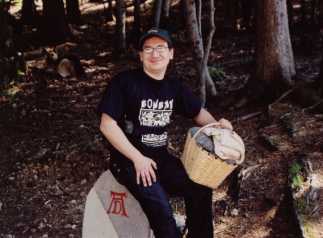The Holy Lake

 Go to the main page
Go to the main page
The Holy Lake (Lago Santo in Italian, Lac Sant in Cembran, Heiliger See in German) is a delightful little lake not far from the town of Cembra, administrative and ecclesiastical “centre” of the valley. To go there it's enough to take the junction to the Lago Santo (precisely), near the western limit of Cembra (route Strada Provinciale 96).
After a few kilometres of steep ascent you reach your destination, about 1200 above sea level (about 4000 ft).
The lake (210×180 metres [690×590 feet], 15 metres deep [50 feet]), rich of fishes  , in the summertime is an ideal destination to fish 1, to go for walks, picnics or to sunbathe.
, in the summertime is an ideal destination to fish 1, to go for walks, picnics or to sunbathe.
During the winter months the zone is often covered by snow and the surface of the lake is generally frozen: in these circumstances the Holy Lake is destination of skating amateurs; you can see from the sign in the picture below, taken during the summertime, that the local government indicates anyway a potential danger (I believe they do it to protect themselves from the legal point of view):

“PERICOLO CEDIMENTO SUPERFICIE GHIACCIATA”
(DANGER OF SUBSIDING OF THE ICE SURFACE)
In the past on the ice of the lake often it was also played the curling: there are several Cembran teams in the Italian championship and the Curling Club Lago Santo was champion in the 2001. Now this sport is played in the new curling rink in Cembra.
Just beside the lake there's the trail covered by Dürer in the 15th century to reach Venice, excellent path for hikes.
The picture below portrays me sat in the “dürerian cippus” that indicates the trail, with the “regulation” picnic basket:

 Go to the main page
Go to the main page
The legend of the Holy Lake
In the toponymy the term holy is generally an euphemism for dangerous  .
.
The Cembran popular tradition, instead, has given a poetical explanation to clear up why this lake is holy.
Once upon a time there were three brothers who have received a wood as an inheritance.
The three, who evidently weren't on good terms, weren't able to agree about how to share it.
One of the brothers one day, exacerbated by the continual arguments, exploded: «May it become a lake!»
As if by magic the wood started to be submerged by the water; actually tree trunks can be still made out inside the lake: they would be the remainders of the mythical wood.
[It reminds me a little bit, in miniature, the legend of the Flying Dutchman who, not succeeding to round the Cape of Good Hope because of the unfavourable see, shouted his blasphemous proclamation: «I'll go on for ever!» and he was condemned by God just to wander over the sees forever].
Anyway the water continued to rise, threatening to cause a flooding and to submerge Cembra itself.
So the frightened population decided to sacrifice the ring that adorned the statue of the Virgin Mary to ingratiate the divine forces: they climbed in procession and threw the precious object into the water that instantly receded, however leaving the pleasant lake to cover the area where once there was the wood.
They say that in the olden days there were people who dedicated time and effort in the attempt to fish out the ring. 
This sounds a little bit similar to a tale by Tolkien, doesn't it?
 Go to the main page
Go to the main page
© 2005, Fabio Vassallo

